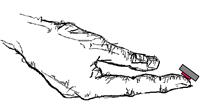Passive Stimulation zur Auslösung von LernprozessenDie zentrale Idee: In den letzten Jahren sind wichtige Prinzipien der Neuroplastizität aufgeklärt worden.
Unter Nutzung dieses Wissens entwickeln wir Stimulationsprotokolle, die Gehirnaktivierungen gezielt verändern, wodurch Wahrnehmung und Verhalten beeinflusst werden.  Wir nutzen unterschiedliche taktile Stimulationsprotokolle (Koaktivierung), um taktile Wahrnehmung beim Menschen innerhalb von Stunden bis Minuten zu verbessern, was auf spezifischen Veränderungen der Gehirnaktivierung beruht:
Je größer die Verbesserung im Verhalten, desto ausgeprägter die cortikale Reorganisation.
Koaktivierung (passive Stimulation)
- verbessert gezielt Wahrnehmung und sensomotorische Fähigkeiten
- ist unabhängig von Aufmerksamkeit oder Belohnung
- ist auch bei Kindern und alten Menschen wirksam
- verbessert Sensorik und Feinmotorik bei Schlaganfallpatienten
Passive Stimulation bietet Einblicke in
- Mechanismen und Prozesse, die Lernen zugrunde liegen
- Zusammenhänge zwischen Gehirn- und Verhaltensänderung
- Neue Interventions- und Therapiemöglichkeiten
Literatur:
Höffken O, Veit M, Knossalla F, Lissek S, Bliem B, Ragert P,
Dinse HR, Tegenthoff M (2007) Sustained increase of somatosensory cortex
excitability by tactile coactivation studied by paired median nerve stimulation
in humans correlates with perceptual gain. J Physiol 584: 463–471
Seitz A, Dinse
HR (2007) A common framework for perceptual
learning. Curr Op Neurobiol 17: 1-6
Kalisch T, Tegenthoff M, Dinse HR (2007) Differential
effects of synchronous and asynchronous multifinger coactivation on human
tactile performance. BMC Neurosci 8: 58
Bliem B, Frombach E, Ragert R,
Knossalla F, Woitalla D, Tegenthoff M, Dinse
HR (2007) Dopaminergic influences on changes in human tactile acuity induced by
tactile coactivation. Exp Brain Res 181: 131-137
Dinse HR, Kleibel N, Kalisch T, Ragert P, Wilimzig C, Tegenthoff M (2006) Tactile
coactivation resets age-related decline of human tactile discrimination. Ann
Neurol 60: 88-94
Dinse HR, Kalisch T, Ragert P, Pleger B, Schwenkreis P, Tegenthoff M (2005)
Improving human haptic performance in normal and impaired human populations
through unattended activation-based learning. Transaction
Appl Perc 2: 71-88
Dinse HR, Ragert P, Pleger B, Schwenkreis P, Tegenthoff M (2003)
Pharmacological modulation of perceptual learning and associated cortical
reorganization. Science 301: 91-94
Pleger B, Dinse HR, Ragert P, Schwenkreis P,
Malin JP, Tegenthoff M (2001) Shifts in cortical representations predict human
discrimination improvement. Proc Natl Acad Sci USA 98: 12255-12260 Godde B, Stauffenberg B,
Spengler F, Dinse HR (2000) Tactile coactivation induced changes in spatial
discrimination performance. J Neurosci 20: 1597-1604
|